With the advantage of environmental compatibility, the demand for green surfactants has been steadily increasing and they may eventually replace their chemically synthesized counterparts. Generally, the surface active reagents that are produced from renewable resources or bioprocesses and are environmentally friendly are considered to be green surfactants. For instance sugar-based polyglucosides and protein based surfactants have been applied in some industrial areas.
These green surfactants have many advantages, such as biodegradability, low toxicity and environmental compatibility and have amphiphatic properties since their complex structures are composed of hydrophilic and hydrophobic portions. For further understanding on green surfactants, their interfacial properties have to been investigated in the comparison with conventional petroleum based surfactants.
So far, several green model surfactants including sugar based maltoside, sophorolipid and lipopeptides have been investigated using techniques like surface tension, fluorescence spectroscopic, total organic carbon analysis techniques. These surfactants have shown unique interfacial properties such as high selective adsorption on solids which can be applied for mineral separation. It is our major aim to understand the unique behavior such as adsorption, as well as their structure-property-performance relationship.

